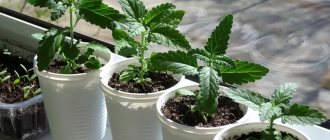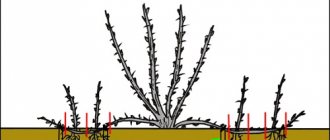One of the hardiest and most unpretentious shrubs is heather, planting and caring for it in open ground will not cause any trouble even for a novice gardener. The plant has excellent decorative qualities, so it is often used in landscape design to create a wide variety of plant compositions.
When can you plant common seasonal heather in open ground in different regions?
Russia extends over 3 climatic zones, so the temperature regime in the regions is different. This affects the duration of the summer season as a whole, and directly on the planting of perennial plants.
In outskirts of Moscow
Heather is sold in nurseries and stores all year round, but this does not mean that planting is also possible at any time. The most favorable time for planting: late April or September. This way the plant will not be damaged by frost and will be able to take root. An important rule: do not buy seedlings in advance. At home, the plant wakes up and begins to actively grow leaves. Heather does not like transplanting.
In Siberia
Planting heather in Siberia is recommended in the spring. It is best to carry out field work in May. Then the plant will have time to take root and grow without the risk of damage to the root system. Landing is allowed in early September. The air temperature this month remains stable, which has a beneficial effect on foreign varieties that do not like temperature changes. But there is a risk that the plant will not have time to take root before the onset of frost.
In the Urals
Although wild heather shrubs are common in the flora of the Urals, planting an ornamental plant in open soil requires a special approach. If we are talking about foreign heat-loving varieties, then it is better to refuse planting in the garden.
It is recommended to plant seedlings in spring. Due to the harsh climate, planting shrubs in the fall is not recommended. As a last resort, you can do this in August.
Heather seeds: collection and storage
One way to propagate this plant is to collect and plant its seeds. Heather seeds are formed in its inflorescences, similar to small boxes, and reach a very small size - about one millimeter. Collecting heather seeds is not difficult, however, for its successful implementation, you need to know some nuances.
In order to have time to collect heather seeds, you need to know the period of its flowering, in particular, when it ends. In most cases, heather begins to bloom in July. And the seed boxes ripen around the end of August - beginning of September, on average within two weeks after the plant has flowered. In order not to miss this moment, it is advisable not to rely on dry statistics, but sometimes check the condition of the flower boxes. The main sign by which you can understand that the seeds are ready is the color: a ripe flower box will be painted in shades of straw color.
Ripe heather seeds must be collected in dry weather, without waiting for the onset of the rainy season and high humidity. Otherwise, wet flower boxes and the seeds in them may rot and deteriorate during the drying process.
The most universal and simplest way to collect ripened seeds is to collect the seeds in a bag. To do this, you need to take a paper bag and put it on a branch with inflorescences that you like. Then tie the bag tightly with the branch inside and disconnect it. Next, the bag with the cut branch needs to be turned over and shaken for several minutes. So the bag can be hung for seed ripening: during the process, the ripened seeds will fall off, and you will only need to indicate on it the name of the seeds and the date of their collection.
Collecting heather seeds is not that difficult. Every person is able to do this. So that your efforts are not in vain and the seeds do not spoil, you need to know how to store them correctly.
After collecting heather seeds, they are left to ripen or dried in a place with good ventilation, without access to sunlight. During the drying period, the seeds should be left on a paper sheet or a dry plate. “Ready” heather seeds, for storage, must be poured into paper or fabric bags and stored in a dark, dry place, with a temperature of 15 to 20 C. In such conditions, heather seeds can retain their properties for a long time, and still not get confused , indicate the date of collection on the package.
How to properly plant heather in open ground at your summer cottage
To successfully plant heather, it is necessary to create conditions as similar as possible to those in which it reproduces in the natural environment. The climate of central Russia is most favorable for active plant growth. Acidic, loose soil is suitable for it. The alkaline and calcareous environment does not allow the shrub to take root properly. Consider this point when choosing a landing site.
Seedlings in the fall to overwinter
Planting heather in autumn is recommended exclusively for central Russia, where winter frosts are not too severe. Only here will it be possible to preserve an unrooted plant until spring. Otherwise, the immature root system will not withstand the cold and the plant will die, even if the young bush is covered and insulated.
If the height of the seedlings is less than 2 cm, planting in open soil in the fall is prohibited. In this case, place the seedlings in pots and keep them at home until spring.
in spring
Heather seedlings are planted in the spring after the soil has warmed up. Shrubs should not be planted immediately after frost. The roots of the plant will die because they will not be able to take root and receive enough nutrients.
In central Russia, plant the plant in late April - early May. If we are talking about more northern regions, landing is possible from mid-May. This will allow the heather to take root deep enough before the onset of cold weather, which will protect the bush from damage.
Top dressing
Heathers have low soil requirements, so they do not need intensive fertilization. There are many heather-friendly products on the market that can be used to give the bushes a little nourishment.
A convenient solution is to use delayed-release formulations in granules. It is also worth paying attention to preparations for soil acidification, that is, urea or magnesium sulfate. Heathers can also be supplied with nutrients high in potassium, which will help the plants bloom well.
A very important element of feeding heather is the introduction of so-called mycorrhiza. This is a natural process involving the symbiosis of plant roots and seeds with fungi. As a result of “cooperation” with these beneficial organisms, the heathers will receive a better water supply and thereby become more resistant to drought.
Nutrients, including those that are difficult to digest, such as iron or phosphorus, will become more available to them. Their resistance to root pathogens responsible for late blight and fusarium will increase, as will resistance to environmental stressors such as toxic compounds from the soil or unfavorable pH. For heather, you can use live mycorrhizal mycelium. It is available at garden supply stores.
Immediately after spring pruning, it is worth feeding the plants, preferably with a slow-release fertilizer. Fast-acting fertilizers must be used wisely because, if applied too intensively, they can cause excessive soil salinity. Heather is very sensitive to this.
Slowly distribute nutrients around the bushes. Do this only once a season, applying 4-5 g per plant. Fast-acting nutrients should only be used 2 or 3 times. They should be applied no later than the end of June (the dose is similar).
You may be interested in:
Platycodon planting and care in open ground Platycodon belongs to the bellflower family. It includes only one species, which in the wild...Read more...
Features of planting
The correct planting of heather is influenced by many factors: from the type of plant to the place from which it was brought. Thus, a wild shrub is less demanding to environmental conditions, but is more difficult to transplant. Decorative is ready for planting, but is more demanding in care.
Store bought
To successfully plant heather, purchase high-quality seedlings. The plant has one peculiarity: the flowers remain beautiful for a long time after damage and death of the root system. Therefore, it is important to know what to look for when choosing a shrub seedling.
Criteria for selecting heather seedlings:
- The soil in the container is moderately moist. Too dry soil leads to depletion of the root system. If there is excessive moisture, the roots quickly begin to rot. This may not be noticeable upon inspection, especially if the container is opaque.
- When examining the container, you should not have the feeling that the plant has just been moved there. It should fit snugly to the base and roots. This will provide protection from excessive air intake and chapping.
- The seedling has old and young shoots. They differ in color.
- There are buds and young leaves on the shoots. They are elastic to the touch.
From the forest
It is difficult to transplant a plant from the forest. Its roots are intertwined with the mushrooms living there, so it is difficult for the shrub to take root in the garden. Create the most similar conditions in the garden, then the likelihood of survival will increase.
Rules for transplanting heather from the forest:
- When removing a plant from the soil in the forest, do not clear the roots from the soil. On the contrary, try to dig them up with a large ball of soil: about 2 times the size of the crown.
- Choose plants that have settled on a dry edge. Their root system is more compact, which reduces the risk of damage.
How to plant?
The planting hole should correspond to the size of the earthen ball around the roots. The free space is filled with soil. The root collar is placed flush with the soil surface. The soil is compacted, mulched with peat and watered. You can apply fertilizer immediately, or you can do it after a while.
When planting, the distance between plants should be no closer than half a meter.
Watering and loosening the soil
Watering should be regular, but not excessive. If the soil is too dry, heather, as an unpretentious plant, will survive, but will bloom sparingly. On hot days, it is advisable to spray the stems and leaves with water. From September, when many varieties of heather are still in bloom, it is recommended to stop watering. The soil needs to be loosened periodically, but carefully so as not to damage the small roots.
Trimming
From the first year after planting, branches should be pruned in autumn or spring. In young specimens, the upper branches are shortened, but not more than 5 cm. In plants that have already bloomed, faded inflorescences need to be cut off.
When pruning, be careful not to remove the flower buds, which in heather are located close to the edges of the shoots.
Top dressing
It is enough to feed heather once a year, usually in the spring, in mid-May. Root feeding is carried out using either liquid or granular fertilizers. Pre-watering is required before applying any fertilizer. It is best to use acidic fertilizers for hydrangeas and rhododendrons. Many people recommend Kemira Combi and Kemira Lux fertilizers.
Any complex fertilizers that contain, in addition to nitrogen, phosphorus and potassium, also microelements are also suitable. But before introducing them, the soil under the plantings is first acidified with peat.
As an organic fertilizer for heather, we can use rotted compost. Applying fresh organic fertilizers will ruin the plantings. The dose of fertilizer is calculated according to the instructions supplied with the fertilizer. Excess fertilizer is harmful to heather: plants become less resistant to diseases. At the same time, annual adequate feeding stimulates plant growth and promotes more abundant flowering.
Some agronomists recommend another feeding in mid-summer. It is performed if the growth of flowering shoots is slow. For this case, any preparations that do not contain nitrogen, for example, potassium phosphate, are suitable.
Where to plant
Heather does not tolerate transplantation well, so choose a location and prepare favorable soil in advance. Typically the plant lives in one place for about 20 years. The shrub is not picky about temperature and environmental conditions. Due to properties such as hardiness and drought resistance, the natural habitat of heather is Africa, North America, moderately cold areas of Europe, and the Alpine mountains at an altitude of 2500 m.
In the shade or in the sun
The plant loves semi-shaded and sunny places, but constantly shaded areas will not do it any good. This is due to the natural conditions for the reproduction of heather. Beautiful flowers bloom on a shrub that grows in direct sunlight. The less sun, the less attractive the blooms.
Choose a place well protected from wind and excessive humidity. If there is a risk of flooding, install drainage.
What soil to plant heathers in and how to prepare the soil for planting yourself
Heather loves acidic soil, so an alkaline and calcareous environment is not suitable for it. In the wild, the plant is common in poor soils, peat bogs and pine forests. For good growth, it is best to create the most similar conditions for the plant.
Loose, breathable soil is recommended. The most favorable is considered to be coniferous soil with decomposed particles of spruce, pine forest, and peat. Add particles of bark and sawdust from coniferous trees, or acidic peat (Ph 4–5) to the soil.
If you choose a low location, be sure to install drainage in a ratio of 1:3 to the soil. Without it, the root system rots due to excess moisture. For drainage, use expanded clay, sand, fine gravel, broken brick. This promotes good flowering.
Caring for evergreen bushes
Heather is a fairly unpretentious plant, but in order to ensure effective growth and development, it needs to be constantly looked after.
The main activities are as follows:
- The bush is regularly watered with high-quality water at room temperature. Watering with too hot or cold liquid is unacceptable. If high-hard water saturated with chlorine is supplied to taps in the region, it should be filtered or allowed to stand for at least 14 days.
- Heather does not tolerate drying out well, so from June to August you need to increase watering. The plant cannot be placed on a south-facing window, as it does not tolerate hot sun. It is necessary that in summer the temperature does not rise above +25, and in winter does not fall below +8 ºС.
- Heather needs to be protected from drafts, but in summer the room can be ventilated as usual.
- A flowering plant should be fed. It prefers acidic soil, so either sulfur or pine and spruce bark is added to the soil.
- With increased dry air, the plant weakens, it may begin to hurt or be attacked by pests. Therefore, heather needs to be sprayed regularly.
- Every year the bush is transplanted into a large container, while the soil on the roots is preserved.
- Drainage and mulching of the soil should be organized in the flowerpot, otherwise the plant may develop fungal diseases.
- In order for heather to live as long as possible, it needs to be pruned annually. To do this, a week after flowering has ended, all branches of the bush are cut off. After 3-4 days, fertilizers are added to the soil to stimulate its growth.
Interesting article about the “heart flower” - the dicentra is magnificent.
What plants can heather be planted with?
Heather gets along best with plants that love the same acidic soil. These are mainly low-growing shrubs (Thunberg barberry), herbs (Masus repens), flowers (grass carnation, Amur carnation, eight-petalled dryad), as well as small coniferous trees and ferns. In decorative design, landscapers in central Russia often use compositions of heather with azalea or rhododendron.
Heathers in landscape design.
Friendship with mushrooms
Over many thousands of years of living on soils poor in nutrients and in a harsh climate, the heather family has not remained unchanged. This family is characterized by mycorrhiza, or otherwise, interaction with fungi. These two species practically do not grow one without the other, to the mutual benefit of both.
The fact is that the roots of mushrooms and the roots of heathers are intertwined and exchange the substances necessary for each of them: the mushrooms give the heathers nutrients, and the heathers also do not remain in debt. This way, each partner gets what they need.
At what distance should heather be planted from each other?
Heather does not like transplanting, so prepare the soil in advance. The area that the shrub will occupy depends on the variety chosen. To get your bearings, count on a distance between bushes of 20–60 cm. Thus, up to 10–15 small varieties of plants, and a maximum of 8 heather bushes of large species, can be placed per 1 sq. m.
Bush planting scheme.
If you plant the seedlings too densely, after 1–2 years the plants will be crowded. You will not be able to get a large beautiful crown. More sparse planting does not harm the heather. The plant reproduces actively and likes to survive other plants in the area. Therefore, monitor this process annually, otherwise only heather will remain in the garden.
Life at home
Where heather grows in the wild and in its historical homeland, it does not require any special care. It truly belongs to that type of plant that is unpretentious and resistant to adverse weather conditions. And pests don’t like it either.
The only danger to heather in the garden may come from neighbors: if tomatoes growing nearby suffer from phytosporosis, then the heather is also in danger. Otherwise, he is a “steadfast tin soldier.”
And this is very attractive, including Russian gardeners.
However, not all so simple. In its climatic zone, heather really does not need anything, because in its native territory everything is already balanced - all that remains is to grow and bloom. But visiting is a different matter: everything there can only be very similar to home. But if one component is missing, then all efforts are useless.
When it blooms
Heather looks very beautiful during the flowering period. Up to 20 small flowers can be seen on racemose inflorescences. The color depends on the chosen variety. The most common varieties are purple and pale pink, but there may be others.
Heather flowering period: from July to mid-autumn. After flowering, the plant remains green and does not harm the garden design. If you live in a mild climate, the heather will live on its own. If you have a harsh winter, especially if there may be little snow, cover the bushes for the winter with spruce branches or any non-woven material to protect them from freezing of the roots.
Answers to readers' questions
What is the lifespan of a plant?
With proper good care, heather can live for more than half a century! At the same time, it is actively growing and can occupy huge areas.
Why does heather dry out?
The shrub begins to dry out, losing leaves and young twigs, when the substrate and air are too dry, especially in hot weather. During such periods, it needs to be watered more often, sprayed every night from a spray bottle.
How to take care of the garden
The key to a lush and blooming garden is proper care of plants, taking into account all the features that have developed during life in the wild. Heather is no exception. The shrub does not require constant attention. Next, I give basic recommendations for caring for heather.
What to feed
A healthy plant does not require additional feeding. Heather is used to living in harsh conditions, so it can obtain all the nutrients itself. If you see that the plant is lethargic, the leaves begin to turn pale, the color is sparse, then feeding is needed.
The bush is fertilized in late spring. Give preference to special additives. But if the store doesn’t have one, take the universal ones. Choose a fertilizer that does not contain calcium. It harms young plants. Fertilize the soil near the plant, not the bush itself. If the fertilizer is in the form of granules, be sure to water the heather well so that the beneficial substances go into the soil.
How to water
When caring for heather, remember the main rule: it is better to under-water than over-water. In the natural environment, the plant tolerates drought better. If your area has average temperatures and rains consistently, additional watering will not be needed.
The shrub needs to be watered only in hot, dry summers. Pour water so that it hits only the root, without touching the crown. Otherwise, rot may appear on the leaves in the form of a gray coating.
For hydration, use acidified water. To prevent moisture from evaporating excessively, the ground must be mulched. Loosen the soil at a distance of 10–15 cm from the bush after watering and remove weeds. This can be done through the mulch without removing it from the ground.
Diseases and pests
Heathers are rarely attacked by pests. Here are the most common ones:
| Gray rot | The most common disease of shrubs. Reason: high humidity, poor drainage and stagnant water. Most often it occurs due to improper watering and shelter for the winter, when the fungus multiplies on the crowns in warm, humid air. If you notice grayness on the leaves and shoots, dying shoots, falling leaves, use Fundazol or Topaz. In advanced cases, treatment with a 1% solution of copper sulfate is effective. If necessary, irrigate once a week. |
| Leaf necrosis | The death of the midrib of a leaf, when the upper part turns brown. Occurs when there are sudden changes in temperature, severe frosts, and lack of moisture and nutrients in the soil. |
| Sunburn | It appears as darkening of flowers on one side of the heather. To prevent problems, do not water or spray the plant during hot hours. |
| Late blight root rot | Manifested by the wilting of the plant. The roots begin to rot from the tips. Dig up the diseased plant with a clod of earth so that the disease does not spread to healthy bushes. Treatment with the following drugs is effective: Ridomil Gold, Fitosporin-M, Planriz. |
| Root cancer | The plant stops growing, the shoots turn yellow, and growths appear on the roots. |
| Mixed chlorosis | The first sign is yellow spots on the leaves. It occurs due to a lack of nutrients and oxygen in the soil. To get rid of the problem, you need to regularly feed the plant. |
Heather diseases.
Do I need to cover it for the winter?
Heathers do not tolerate winter well. In the absence of snow, the roots freeze and the plant dies. If the winter is snowy, a layer of snow covers the bush, and a crust of ice forms on top, which prevents the plant from breathing. Heather should always be prepared for winter.
- In a radius of 10–15 cm, mulch the plant with a thick layer of fallen leaves or peat.
- Cover the plant with spruce branches.
Such manipulations will help protect the bush from frost and wind, but at the same time provide access to air. The needles gradually fall off and rot, which further oxidizes the soil.
After the end of frost, remove the spruce branches and move the mulch away. If this is not done, the heather will bloom poorly.
How to deal with diseases and pests?
The most common disease in heathers is gray rot. It develops at high air and soil humidity. As a rule, this happens in places where a lot of snow is retained or rainwater accumulates. Plants that were covered incorrectly or when the cover was removed very late are also damaged by rot. Have the heather leaves turned brown and the tops of the shoots are withering? This is a consequence of waterlogging or excess fertilizer in the soil. For treatment we use antifungal drugs.
Symptoms of a viral disease are deformation of shoots and flowers, uncharacteristic coloring of foliage. If the plant is affected by viral infections, you will have to part with it so as not to infect the rest of the plantings. We dig up the affected bush and then burn it.
Cuttings
Cuttings are one of the simplest and most effective methods. To reproduce, the plant must have young, but not flowering, shoots, so the most favorable time for the procedure is summer. Do not use flowering shoots for cuttings. They do not take root well and rarely grow into large shrubs. As a last resort, shoots that have already bloomed can be separated from summer-blooming heathers.
For planting, use a mixture of sifted peat and sand. If you don't separate out the large particles in the peat mixture, it will be difficult to separate the plants. Firm the soil in the container so that it does not reach 1 cm from the top edge.
If you want to propagate different varieties of heather, do not use one container for this. Each type of shrub has its own characteristics of the root system, so young plants harm each other.
Algorithm for planting cuttings:
- Cut vegetative shoots from the plant.
- Remove the lower leaves of the shoot. This will be the cutting for planting.
- Make holes half the length of the cutting and place it in the hole. Do not compact the soil after planting. Plant the cuttings 20mm apart.
- Water the heather with a fungicide solution.
- To speed up rooting, keep the container with cuttings in a warm room with high humidity. It is better to cover the vessel with glass or film.
- The first shoots appear after 2–4 weeks. After this, remove the glass and harden the cuttings.
- To plant rooted cuttings, remove them from the container and carefully separate them. After this, plant the plants in separate pots.
- The plants will be ready for planting in open ground no earlier than in 2 years.
Algorithm for planting heather cuttings step by step.
Dividing the bush
This is the easiest way to propagate heather. At the end of August or autumn, dig up a bush with a large lump of earth so as not to damage the root system. After this, it is necessary to remove all faded buds and tall shoots. There should be some low stumps left.
Now the plant is ready for propagation by dividing the rhizomes. Carefully divide the bush into several parts. Plant new plants in pre-prepared holes. Don't forget to water the heathers well to help them take root faster. Mulch the bushes and prepare them for winter.
In the spring you will see young shoots. This means the heather is rooted and ready to grow.
By layering
This method is used in the spring. To propagate, select a healthy plant and separate a strong branch from it (but do not cut it). Remove all the leaves and bend it to the ground. Use wire to secure the branch in the hole.
Secure the part of the branch that remains outside to the base. Water the plant regularly with warm water. In autumn, the plant is ready to separate from the mother. Now carefully cut the branch from the bush.
Next year, plant the young plant in a new location as needed.
Heather propagation by layering.
Seeds
Propagation of heather by seeds is a labor-intensive and lengthy process. To obtain seedlings it will take 2 years. To successfully grow heather, you need to prepare the seeds for planting:
- Place the seeds in a 2 mm layer in a glass.
- Add a little water to moisten all the seeds.
- Cover with film.
- Wait 2-3 weeks for the seed to germinate.
- Open the film and leave it for a few days to harden.
When the seeds are ready, plant them in large containers in special soil. Air temperature 18–20 degrees. You need to wait about a month before germination. Do not forget to monitor the moderation of humidity in the room and in the soil. In the warm season, periodically take the seedlings outside to harden the seedlings.
Seedlings
If you grow seedlings from seeds yourself, it will take you more than 2 years. Seedlings should be periodically taken out into the open air, and should not be allowed to stay in temperatures below 10–12 degrees.
It is much easier to grow heather from seedlings purchased from a nursery. After purchasing, immediately plant the seedlings in pre-prepared soil at a distance of 20–60 cm from each other, depending on the variety. Compact and mulch the soil after planting. If the soil in the area is clayey, install drainage.
Growing heather from seeds
How to sow seeds
Growing heather from seeds is a rather lengthy and labor-intensive process, but the high degree of seed germination - about 90% - inspires optimism. Heather seeds are placed in a bowl on top of a moistened substrate in a thin layer, without covering, and kept under glass until shoots appear.
The best substrate for germinating seeds is a mixture of coniferous soil, sand and peat in a ratio of 1:1:2. Crops need to be kept at a temperature of about 20 ºC, and for the first week it is necessary to create a high level of humidity for the seeds. Sprouts begin to appear after a month. As soon as the shoots appear, they begin to harden, briefly lifting the glass for ventilation. As soon as the seedlings grow and begin to interfere with each other, they are planted in containers or pots.
Seedling care
With the onset of summer, the seedlings are taken out into the garden and placed in partial shade, watering as needed, and with the onset of cold weather, the container is brought into a room where the air temperature is maintained within 10-12 ºC. Heather seedlings are planted in a permanent place after two years. It should be remembered that heather from seeds does not inherit its parental characteristics, but as a result of your efforts, a new variety may appear, which, quite possibly, will become your personal achievement.
Features of planting popular species and varieties
The general rules for planting heather are the same, but due to the characteristics of some varieties, nuances may arise. Keep in mind that ornamental species are more delicate and therefore require more care than their forest relatives.
Alba Plena
Heather is distinguished by small white flowers and low shoots that grow tall. It grows slowly, so planting can be more dense.
Alexandra
Heather has low bushes with a purple color and dark green leaves. The variety is distinguished by its spherical shape.
Alicia
The plant is distinguished by large white flowers on bushes up to 20 cm high. It blooms in the first half of summer. Not picky about soil, grows slowly. Plant Alicia 20-25cm apart.
Allegro
The plant prefers sunny, open areas and grows up to 60 cm in height, so plant seedlings at a great distance (about 100 cm) in holes 40 cm deep. The variety does not tolerate cold well and can die from the first frost, so prepare it for winter in advance. Allegro is resistant to pests and diseases.
Boscoop
Heather is characterized by bushes up to 35 cm tall with lilac-pink flowers. It blooms from August to September and tolerates drought and prolonged heat.
Hamilton (JH Hamilton)
The plant has a rounded shape, about 30 cm high. Sometimes bushes up to 60 cm are found. The flowers are collected in light purple inflorescences. Hamilton blooms from July to September. This heather needs to be watered only during prolonged dry heat.
Garden Girls
Bright pink flowers grow on a crown 20 cm high. It blooms in late summer until frost. It tolerates winter well; in the conditions of central Russia, it most often does not need winter insulation. It does not tolerate moisture well, so it is best to install drainage when planting.
Gold Haze
The variety is distinguished by large snow-white bell-shaped flowers. The leaves are bright lemon color. The plant reaches a height of 60 cm, so the required distance between bushes is 50–100 cm.
Dark Beauty
The variety is distinguished by light red flowers. Crown diameter up to 40 cm. The plant does not tolerate moisture well, so it requires drainage when planted in low areas. The shrub blooms until the end of November. It has a large root system and does not tolerate dense planting.
Calluna Beauty Ladies
The bushes grow up to 40 cm high and have lilac flowers. It is recommended to plant up to 8 pieces per 1 square meter. m.
Carmen
This is a variety of heather with a wide but compact crown up to 40 cm high. The color of the flowers is pink-violet. Does not tolerate frost well.
Marlies
The plant reaches 30 cm in height, the crown width is approximately 50 cm. Therefore, the recommended distance between plants is about 100 cm. It is distinguished by pink or purple flowers.
Silver Knight
The variety was bred in England. The crown is approximately 40 cm in diameter and up to 30 cm in height. The bark is gray-silver or brown, the flowers are lilac and lavender. The plant is resistant to cold, but in harsh climates it needs to be covered.
Spring Cream
The shrub pleases the eye with snow-white flowers. Undemanding in care, tolerates both heat and frost. Blooms from August to October. Crown height up to 35 cm.
Firefly
An adult plant reaches a height of 40 cm. Heather tolerates frost well and belongs to frost resistance class 4. The color is pink-violet, blooms from August to October.
Botanical description
Just half a century ago, common heather (C. vulgaris) was not on the list of popular plants for gardeners. However, today the residents of our country appreciate its discreet beauty and are trying to decorate their gardens with it. Before we start talking about growing heather, let's find out its botanical characteristics.
Most often, the idea of heather is limited to modest knowledge: it is a bush consisting of many stems strewn with small flowers of lilac shades.
To put it mildly, this is very modest knowledge. Heather (Calluna) belongs to a family that is represented by more than 140 genera and approximately 3,500 species. They are united by the so-called “ericoid appearance”: stems covered with small flowers. And by the way, their shades are not only lilac, but also white, bright yellow, light brown, etc.
The common heather has long been no longer a resident of only Scotland or other northern countries: this traveler penetrated the territory of Europe and began to capture the south of Italy.
Breeders are working to create more and more new varieties, experimenting with the color and texture of flowers and leaves. Recently introduced varieties with the characteristic feature of flowers that retain the appearance of unopened buds (Garden Girls) are becoming especially popular in countries with warm climates. Somewhat earlier, varieties were obtained that were distinguished by the double texture of the flower (Peter Sparkes) and curly stems. However, as statistics show, these options are not for our latitudes.
Gardener mistakes
Although heather is an unpretentious plant that is resistant to different weather conditions, not everyone can grow heather in their garden. Most often this happens due to mistakes that gardeners make when planting and caring for shrubs.
The main mistakes when growing heather:
- Planting in ordinary garden soil. An alkaline environment is not suitable for heathers, no matter how carefully you care for them. It is necessary to prepare the soil for planting: bring in peat, bark, spruce, and oxidize the soil.
- Planting shrubs in the shady part of the garden. A beautiful lush crown can only be obtained from a plant located in the sun or partial shade.
- You notice that the plant lacks nutrients, but do not apply oxidative fertilizer.
- Too frequent watering or prolonged lack of moisture. In the case of heathers, it is better to underwater than overwater to prevent stagnation of moisture in the soil. But nevertheless, during prolonged drought, which is accompanied by high temperatures, it is necessary to water the bushes.
- Planting heather at the wrong depth. If the roots are not placed sufficiently or too deeply, the heather does not grow well.
What to look for when choosing a seedling
If you went to the garden center to purchase a heather seedling, listen to the advice below. They will help you choose healthy planting material that can eventually turn into a beautiful flowering bush.
- Appearance. First of all, look at what the bush looks like. It is important that there are buds on it. This is a litmus test that indicates that the plant is healthy. It is also important that the heather has young branches. This is also considered a sign of high-quality planting material.
- The soil. If the plant you purchase is sold in a container, be sure to feel the soil in which the heather “sits.” The soil should not be too dry or too moist. Drought and excessive humidity are the main enemies of the bush. This is especially true for soil that contains too much water: excessive moisture quickly destroys the root system.
- Adhesion of the container to the ground. It is also important that the soil in the container is in close contact with the walls of the container. Otherwise, air will get into the crevices between the soil and the wall of the container. And this is an extremely undesirable phenomenon. And it’s not a good sign, which only confirms the fact that the heather in the garden center was poorly cared for.
Reviews from gardeners growing heather on their property
Maria, 53 years old
I bought Heather by accident. I just liked the look. I started reading at home about what to do with it, and realized that there would probably be another dried flower in the flowerbed. Everything seemed so complicated. But she dropped me off anyway. He survived a winter, then a drought, then another winter. Now I have already planted it and grown into half the garden. I also bought different types. Blooms from late June until winter. Beauty.
Mikhail, 48 years old
A few years ago we finally moved into our house and the question arose of improving the area. There is a problem. The soil is acidic. This narrowed our design options. My wife ordered various seedlings on the Internet, and we got to work. Everything was planted in the fall. There were trees and bushes there. I was worried about how they would survive the winter. Our frosts are severe. Everything took root. Even heathers. Even though I thought the frost would kill them, they were planted too late. 3 years have passed, there are already shoots. Blooms well. The wife is happy.
Ekaterina, 62 years old
I saw heathers at my neighbor's place. They bloom so beautifully. For six months. I asked for a few branches when she was seating them. I had to dig around a bit, it turns out that the soil there is not so easy, it needs to be oxidized. But fortunately, the stores now have everything. I don’t have a plantation yet, but everything is ahead. They don’t need anything except fertilizer now. This can be planted.
Use of heather
Heathers are famous not only for their appearance, but also for their beneficial properties. They have been used in agriculture and medicine since ancient times.
In old times
In botany, the plant is known as Calluna. The word comes from the ancient Greek “to sweep.” This is directly related to the basic function that people used many hundreds of years ago. Heather makes a strong broom.
The Irish and Scots used bushes in construction. Dry heather stems were mixed with clay and straw and used as building material. You've probably seen photographs of old huts completely covered with branches.
The hut, covered with branches, may well be partly made from dried heather.
The leaves of the bushes were collected and dried. This is an excellent filling for mattresses.
The shoots were used for weaving baskets. And dried heather in the mountainous areas was almost the only heating material.
In medicine
Due to its beneficial properties, heather has found use in folk medicine. Since ancient times, it has been used to prepare medicines for various diseases:
- as an antibiotic for urinary tract infections;
- with prostatitis;
- from urolithiasis;
- for snake and insect bites;
- as a diaphoretic;
- from problems with the gastrointestinal tract: colic, diarrhea, unpleasant painful sensations, gastritis, enterocolitis, dysentery;
- for skin diseases, burns and wounds;
- for inflammation of the oral cavity;
- to relieve symptoms of tuberculosis;
- against hair loss with local rubbing.
Today the plant is used in homeopathic medicine. It is used to get rid of toxins.
Research shows the effectiveness of heather extract in the treatment of rheumatoid diseases.
You may be interested in growing a knotweed flower in your garden, because it also has medicinal properties.
In landscape design
Heathers are often used in landscape design. A variety of colors, shapes and sizes allow you to decorate the garden of the most sophisticated connoisseur. The plant blooms for 3 to 6 months and combines well with other shrubs and flowers, allowing you to create a variety of compositions.
I often use heathers when creating alpine slides. They are used as ground cover plants, thanks to which weeds do not multiply.
Heather looks truly magnificent in landscape design.
The shrub attracts the attention of honey plants, therefore it is valued by beekeepers.
I also recommend decorating the garden with daisies, and how to make the right choice is described in the article “What perennial varieties of daisies to plant in the garden.”
conclusions
- Heather is a perennial plant that requires little care.
- It is better to plant heathers in spring.
- Be sure to oxidize the soil before planting.
- Heather does not like excessive humidity. If there is a risk of flooding, install drainage.
- Most varieties of heather need to be watered only during prolonged hot weather and drought.
- In central Russia, the shrub survives in winter without insulation, but it is still better to prepare it for wintering.
- Heather can be propagated by layering, seeds, seedlings, or dividing the bush.
- The plant is rarely susceptible to disease.
- Due to its beneficial properties, the plant is used in agriculture, medicine and landscape design.
Life away
Heather loves to grow near or on the territory of a coniferous forest. Coniferous litter represents an ideal soil structure for the heather family, both in terms of looseness and composition. In addition, the lighting in such a landscape will be almost ideal.
The next factor: acidic soil reaction, which may be near peat bogs. This does not mean that heather grows on moors, but it is quite possible nearby. Sandy soils may also be suitable for heather, provided they are acidic. And don’t forget about mycorrhiza: without this component, little can happen.
When planting heather, you should adhere to seasonal rhythms: like all wild plants, it begins to wake up in the spring. As for flowering, slight deviations are possible depending on the climate.











